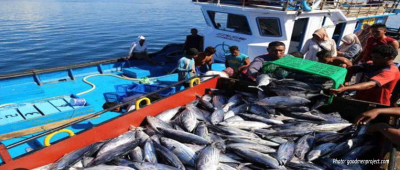INDONESIA:Indonesia is developing tuna farming in the country’s bays in an effort to boost its aquaculture sector and ease the pressure on its world-leading marine tuna fishery.
The fisheries ministry said it was consulting with international fisheries experts about implementing tuna farming.
Indonesia’s archipelagic waters are key fishing grounds for several many tuna species, as well as spawning grounds for the fish.
Indonesia’s tuna fisheries is an important source of livelihood for coastal communities and a key source of food for consumers around the world.
LEGIAN — Indonesia is developing tuna farming in an effort to boost its aquaculture sector and lift some pressure from the world’s largest marine tuna fisheries.
Indonesia catches more tuna than any other country, accounting for about 16% of the world’s total tuna supply. However, intensive fishing of wild tuna from the country’s waters has made the fishery unsustainable, with much of Indonesia’s fishing grounds in the Pacific and Indian oceans already fully exploited, and many tuna species subject to overfishing.
The Indonesian fisheries ministry has over the years rolled out a string of measures to keep tuna production at sustainable levels, including by introducing harvest controls, monitoring certain species in a few fisheries areas, managing the use of fish-aggregating devices, and encouraging the fishers to achieve international-standard sustainability certification. To expand on these measures, the ministry is now looking into establishing tuna farms in the country’s bays.
“This can be a good thing if we can develop it in Indonesia,” Sakti Wahyu Trenggono, the fisheries minister, told reporters at a press conference May 24 in Legian, Bali. “No more massive tuna catching, but instead, an option is to catch them and then grow them for a certain period and give them high economic added value while also supplying protein demands.”
Institut Teknologi Sepuluh Nopember (ITS) has succeeded in establishing itself as a maritime campus by building the first marine offshore aquaculture building in Indonesia
Sakti said catching wild tuna to be put into sea pens would require different skills and techniques than fishing them. He said he had consulted with a fisheries expert from Turkey and would reach out to others in Australia on tuna-farming techniques. He added the Turkish expert had highlighted Indonesia’s potential to become the world’s biggest tuna-farming country.
“We have many great bays across our country, but especially in the eastern parts,” Sakti said, adding that potential sites include Kupang in the East Nusa Tenggara province and Morotai in Maluku province.
Indonesia’s archipelagic waters are fishing grounds for albacore (Thunnus alalunga), yellowfin (T. albacares), bigeye (T. obesus), and southern bluefin tuna (T. maccoyii). Other areas around the country’s 17,000 islands are key spawning grounds for the fish.
Indonesia’s tuna fishery is an important source of livelihood for coastal communities in the country and a key source of food for consumers around the world. In 2021, the country produced 791,000 metric tons of caught tuna, valued at 22 trillion rupiah ($1.5 billion). Exports amounted to 174,764 metric tons, valued at more than 10.6 trillion rupiah (more than $710 million), destined mostly to the United States, Japan, Thailand, Saudi Arabia, the European Union, Australia, Vietnam, the United Kingdom and the Philippines.
The government is also pushing for more tuna fisheries in Indonesia to obtain sustainable certification and eco-labeling. Various schemes exist to certify that fish stocks are sustainable, environmental impacts are minimized, labor rights are respected, supply chain transparency and traceability are in place, and management is governed by best practices.
At the start of his second term in office, in 2019, President Joko Widodo ordered the fisheries ministry to boost the country’s aquaculture productivity. Global aquaculture production grew by 527% from 1990-2018, with Indonesia among the top producers worldwide. The country’s aquaculture output in the third quarter of 2021 was 12.25 million metric tons, a 6% increase from the same period in 2020. The aquaculture sector contributed the equivalent of $1.94 million in non-tax state revenue for the year to November 2021, well above the target figure of $1.39 million, according to the ministry.
Source: Basten Gokkon/goodmenproject.com

